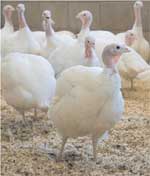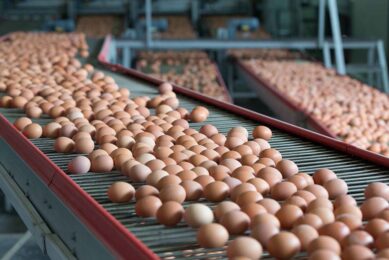Early detection for effective broody control

Despite genetic progress and good flock management, broodiness among turkey females can still occur, particularly in hot climates. Prevention remains a key factor in minimising this behaviour. This includes early detection, but also practical measures to quickly get females back onto the laying path.
By Dr. Carlo Norci, Management Specialist, Aviagen Turkeys, UK
In the wild, a female turkey will begin laying eggs in the spring, stimulated by increasing day length. Once she has laid a clutch of 10-15 eggs she will sit on them until they hatch and cease to lay more eggs. This is known as broody behaviour, caused by a build up of the hormone prolactin in the bloodstream. Broody control describes the husbandry techniques used to prevent females from becoming broody and so maintain egg production. Generations of selection have reduced the tendency of hens to become broody, however, without proper management broodiness can still have a significant impact on overall egg production, especially in hot climates.
Factors that promote broodiness • Hot weather • Allowing hens to sit on eggs (e.g. insufficient egg collections, leaving hens in nests after collection, and allowing hens to sit on nests overnight) • Allowing hens to sit on floor eggs • Starting broody control too late • Poor uniformity of the flock |
The most important aspect of successful broody control is prevention. Early identification of females becoming broody is essential, or they will stop producing eggs for the rest of the laying cycle. In commercial conditions females begin showing signs of broodiness 3-4 weeks after the start of lay, so broody control should begin in the second week of production. Starting too early can affect the achievement of a good peak, and starting too late will result in some birds that are already broody. It is important that broody prevention is carried out every day. A sudden drop in egg production after peak lay can be an indication that a broody problem has developed.
Females should be trained to use the nest boxes before and in first weeks of production, and actions should be taken to prevent eggs being laid on the floor. Floor layers are encouraged by:
– Dark corners
– Uneven lighting
– Low light intensity
– Objects or obstacles in the pen
– Allowing sitting or crowding in corners
– Having the wrong ratio of birds per nest
– Insufficient frequency of egg collection.
Identifying broody hens
Producers and employees need to be aware of the signs that should be kept in mind. Being aware of these signs will lead to better and faster prevention.
The broody female will spend a large proportion of her time on the nest. When approached, the hen might display aggressive behaviour. This could include hissing, raised back/neck feathers, as well as pecking. She will also struggle to remain on the nest. Another tell-tale early sign of broodiness is the production of distinctive smelling faeces when the oviduct is everted. As broodiness develops the oviduct becomes dryer and harder to evert, the pelvic bones move closer together, and the skin between the bones becomes taut. Note that in the first three weeks of lay it should be possible to place three fingers between the pelvic bones if the female is not broody (palpation).
There are several systems that can be used to help identify broody females, namely inspection, spray marking, net/curtain system, and pen switching.
Inspection
Females found on the nest first thing in the morning or last thing at night (at least 20 minutes after the last egg collection) are inspected by palpation on the nest or by removing the bird and everting the oviduct. The nest box should be designed to allow easy removal of the bird from the back. It is useful to have a person at the front of the nest to prevent females escaping before being inspected.
The advantage of this system is that it can be very accurate. Additionally, it does not remove non-broody females from the laying pen. The disadvantage, however, is that it requires skill and training, and it is more labour-intensive. Additionally, it is not really suitable for auto nests, and does not provide early identification of non-physical broody signs.
Spray marking
This system is based on nesting behaviour and gives an early indication of broodiness. All females found on the nest at the first egg collection in the morning or last thing at night (at least 20 minutes after the last egg collection) are sprayed with a colour marker. The following evening or morning any birds on the nests with the same colour can be assumed to be broody. Each day a different colour should be used. It is therefore important to use colours that will not persist too long (e.g. dilute food colorants or children’s water-based paints).
The advantages here are that it is really easy to operate, and minimal training is required. The disadvantage, however, is that the hens can become multi-coloured. If nest access is restricted at night then spraying at night will not work.
Net/Curtain system
This method utilises a net or curtain 2-3 metres in front of and parallel to the nest boxes. The curtain is raised during the day, allowing free access to and from the nests. After the last collection of the day, all females are pushed off the nests. About one hour later females in the area between the nests and the curtain are driven into the main pen and the curtain lowered. This leaves potentially broody females sitting on the nests. Non-broody females that are still on the nests in the evening will be in the area between the nests and the curtain in the morning and can be driven back into the main pen. Any birds remaining on the nests can be assumed to be broody and should be removed from the laying pens.
The advantage of this system is that very little training is required, but the major disadvantage is that this method can deprive non-broody females of access to feed and water overnight.
Pen switching
Pen switching may be the only practical alternative in hot climates (where the build-up of broodiness can be quite rapid), or if other methods have not been successful. This method involves switching all the birds from one pen into another pen. The small change in environment and different nests can deter broodiness. However, there will also be a temporary loss of egg production at the time of switching. Pen switching should not be done before peak egg production, but should be done as soon as possible after the peak. The ideal time is when production has declined for two consecutive days after the peak. Pen switching must always be done in the late afternoon, and is more effective in open-sided naturally ventilated houses.
The advantage is that this system can be the most effective in hot climates, but the disadvantage is that egg production will be temporarily reduced.
Treating broody hens
Females identified as broody must be moved from their favoured environment (a warm, dark, comfortable nest) to an uncomfortable area without a nest, known as a broody pen (Figure 1). The broody pen usually consists of a series of pens in the coolest part of the laying house, preferably with a higher light intensity than the normal laying pens. Up to 10% of the house is required for broody pens (15% in hot climates). Each pen will ideally have a different floor covering (e.g. sand, shavings, concrete, wooden slats, etc.) to the main laying pens. Additionally, each pen must be equipped with adequate feeding and drinking space, as deprivation of either will permanently stop broody females from laying. A 4-pen system is most successful with each pen having easy access and being inter-connected, allowing females to be moved from one pen to another. The first pen should have 40% of the total pen area as this will receive suspect broody hens daily. The females should be inspected and handled daily, and any non-broody hens returned to the laying pens along with any birds seen squatting or laying an egg. Generally, broody treatment lasts 3-4 days, after which females begin laying again (provided they were identified early enough).
Although genetic selection has reduced the tendency for broodiness, it is still important to practice broody control in order to maintain egg production. This is especially true in hot climates and/or when the minimum housing requirements are not respected. Prevention is the key to successful broody control.
Join 31,000+ subscribers
Subscribe to our newsletter to stay updated about all the need-to-know content in the poultry sector, three times a week. Beheer
Beheer








 WP Admin
WP Admin  Bewerk bericht
Bewerk bericht